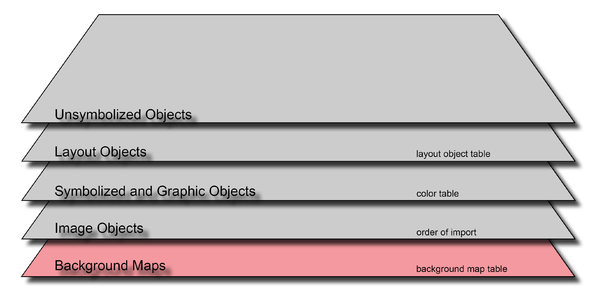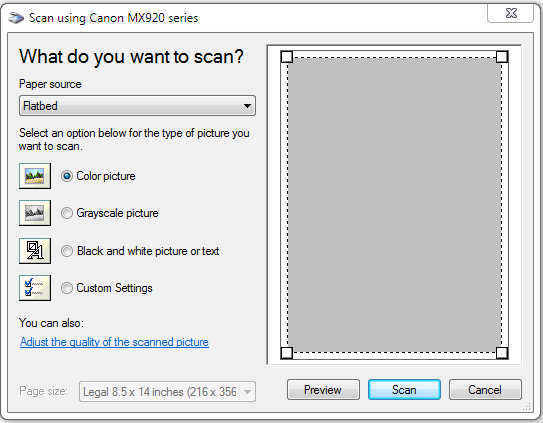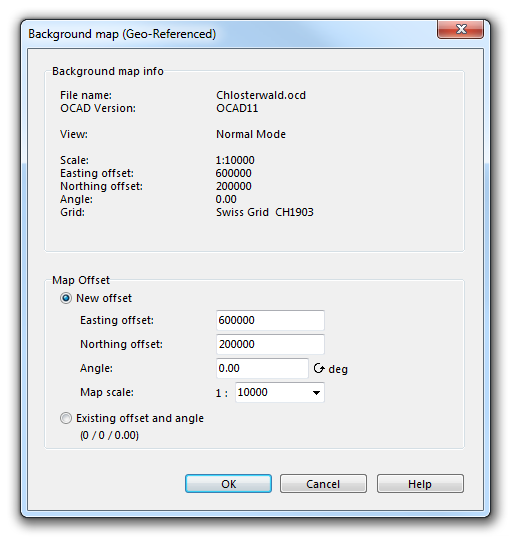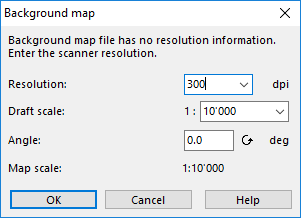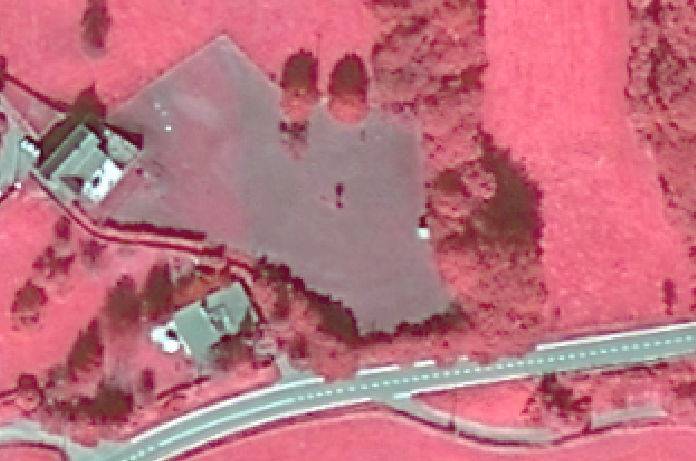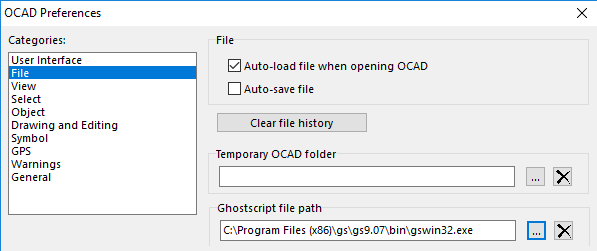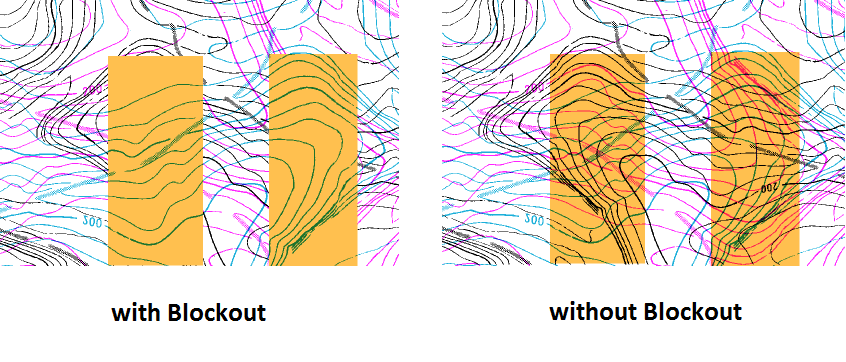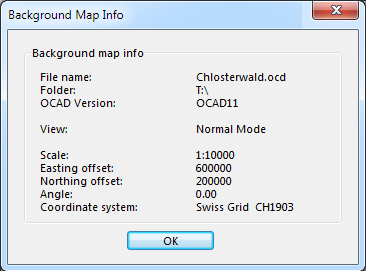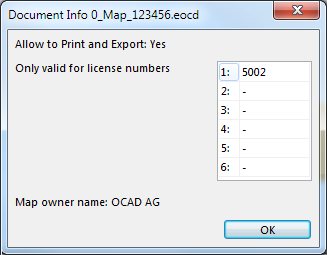Background Map: Difference between revisions
| (161 intermediate revisions by 12 users not shown) | |||
| Line 1: | Line 1: | ||
Background map refers to a raster map or OCAD file used as a background. It serves as a drawing template or background image. Examples include scanned draft maps, satellite pictures, orthophotos or relief shadings. OCAD cannot be used to edit background maps. | |||
[[File: | [[File:Order_BackgroundMap.png|x300px]] | ||
''' | ==Scanning a Background Map [[File:Space.PNG]][[File:Pro40px.PNG|This function is available in OCAD Professional.|link=https://www.ocad.com/en/products/ocad-for-cartography]][[File:Std40px.PNG|This function is available in OCAD Orienteering.|link=https://www.ocad.com/en/products/ocad-for-orienteering]]== | ||
It is recommendable to keep with the following two things: | |||
* '''Use a grid:''' In most cases you cannot scan the entire draft map (the background map). You are either limited by Windows (which limits the maximum size of background maps), by the available memory, or by the size of the scanner (A4). In these cases, it is strongly recommended that you should draw a grid on the draft map. In many cases there is already a kilometer grid which can be used. If this does not exist, you should draw a precise grid of vertical and horizontal lines (perhaps at a distance of 10 cm). Then the scanned pieces can be easily joined together in OCAD. | |||
* '''Resolution:''' It is recommendable to scan the map with 300 dpi. | |||
OCAD supports only WIA compatible scanners. Click '''Scan''' in the '''Background map''' menu. The Scan dialog opens. | |||
[[File:ScanDialog.png]] | |||
Choose the extent and click '''Scan'''. You have the option to save file file in jpg, bmp or png file format. Then the scanned background map is opened. | |||
==Open a Background Map [[File:Space.PNG]][[File:Pro40px.PNG|This function is available in OCAD Professional.|link=https://www.ocad.com/en/products/ocad-for-cartography]][[File:Std40px.PNG|This function is available in OCAD Orienteering.|link=https://www.ocad.com/en/products/ocad-for-orienteering]][[File:Sta40px.PNG|This function is available in OCAD Starter.|link=https://www.ocad.com/en/products/ocad-for-orienteering]][[File:CS40px.PNG|This function is available in OCAD Course Setting.|link=https://www.ocad.com/en/products/ocad-for-orienteering]]== | |||
Choose this command from the '''Background Map''' menu to open a background map which is displayed as a background picture on the screen. OCAD can open ''BMP, GIF, [[Background_Map#Open_pdf_as_Background_Map|PDF]], PNG, TIFF, JPEG'' and ''TIFF'' files. In addition, OCAD maps (*.ocd) or '''[[Export_Files#Export_Encrypted_File|Encrypted OCAD maps]]''' (*.eocd) can be loaded as a background map, too. The '''Open Background map''' dialog appears. Choose a file and click the '''Open''' button. | |||
'''Note:''' In the '''OCAD Starter Edition''', '''OCAD''' (.ocd) and '''[[Export_Files#Export_Encrypted_File|Encrypted OCAD Maps]]''' (.eocd) are only available to use as a background map in course setting projects. | |||
[[File:Hint.jpg|hint]] Ocad 12 can load only encrypted Ocad files exported from OCAD 12. Encrypted Ocad 10 or Ocad 11 files are not compatible with Ocad 12. | |||
''' | [[File:Hint.jpg|hint]] OCAD loads the background map hidden when pressing the '''Shift''' key while clicking the '''Open''' menu item. | ||
'' | [[File:Hint.jpg|hint]] OCAD does not support ''JPEG2000'' and ''ECW'' files. We recommend to transform them to TIFF with tools like [[IGNMap]]. | ||
===Use a Georeferenced Raster Map as Background Map=== | |||
If your map is georeferenced and you want to use a georeferenced map as background map: | |||
# Select the '''Open''' command in the '''Background Map''' menu. The '''Background Map''' dialog box opens. | |||
# Select a file and click the '''Open''' button. | |||
# The '''Background Map (Geo-Referenced)''' dialog appears and shows the geo-referencing of the selected map. | |||
#* Select the '''New Offset''' option to create a new map offset. The center of the map will be moved to the offset you typed in the '''Easting''' and '''Northing Offset''' fields and rotated with the angle entered in the '''Angle''' field. In addition, the scale can be changed. | |||
#* Select the '''Existing Offset and Angle''' option to leave the map as it is. The background map will be placed at the correct position with reference to the existing map offset and angle. If you choose this option, the background map may be placed outside the map range. In this case, an error message will appear. | |||
#: [[File:BackgroundMapDialogGeoreferenced.PNG]] | |||
# Click the '''OK''' button to finish. | |||
<br /> | |||
[[File:Hint.jpg|hint]] - Click the '''Entire Map''' button to display the entire background map. | |||
: - The '''Draft Mode''' option in the '''View''' menu can be used to dim map objects and the background map itself. | |||
: - Ocad files can also be loaded as background maps. | |||
<br /> | |||
[[File:Camera.jpg|video available]] [http://www.ocad.com/howtos/71.htm Background Map Basics] | |||
===Use a Non Georeferenced Raster Map as Background Map=== | |||
If your map is georeferenced and you want to load a non-georeferenced map: | |||
# Select the '''Open''' command in the '''Background Map''' menu. The Background Map dialog box opens. | |||
# Select a file and click the '''Open''' button. | |||
# Enter a resolution for the background map (if a raster map is loaded) and click the '''OK''' button. | |||
[[File:NonGeoreferencedRasterMap.png]] | |||
The background map is displayed at the center of the current drawing area. The raster map (background map) now needs to be adjusted with the map ('''[[Background_Map#Adjust_a_Background_Map|Adjust a Background Map]]'''). In other words, it needs to be referenced with the map coordinate system. | |||
<br /> | |||
[[File:Hint.jpg|hint]] You can scan a raster map to use it as a background map directly in Ocad: Select '''Scan''' in the '''Background Map''' menu and then choose the '''Acquire''' submenu. Your scanner's dialog box will open ('''[[Background Map#Scanning a Background Map|Scanning a Background Map]]'''). | |||
=== Infrared Images === | |||
OCAD supports 32-bit infrared tiff images. When opening an infrared image Ocad shows the following message box: | |||
[[File:MessageBoxInfraredImage.png]] | |||
Click '''Yes''' to show the background map as false-color image using the infrared, red and green spectral bands mapped to RGB. | |||
[[File:InfraredImageFalseColors.png]] | |||
Click '''No''' to show the background map as true-color image. | |||
[[File:InfraredImageTrueColors.png]] | |||
===Error or Warning Messages=== | |||
==== Error Message Not enough memory for the background map ==== | |||
This error message appears if Windows cannot provide the memory needed to load the whole background map. For uncompressed background map files the size of memory needed is about the file size. Compressed background map files have to be expanded in memory and therefore need more memory than their file size. | |||
[[File:hint.jpg|hint]] If Ocad 64-bit version is used, background map files bigger than 2.1GB can be loaded. | |||
==== Error Message TIFF variant not supported ==== | |||
This error message appears if the TIFF variant is not supported by the current version of OCAD. | |||
==== Error Message This TIFF file contains tiles. OCAD does not support TIFF files with tiles==== | |||
This error message appears if the TIFF contains tiles which OCAD doe not support. Please convert this file into an untiled TIFF format. | |||
==== Error Message Compression type not supported ==== | |||
This error message appears if the compression in the opened TIFF file is not supported by the current version of Ocad. | |||
==== Warning The background map is geo-referenced in the scale 1:x but the open map is in the scale 1:y ==== | |||
[[File:WarningOpenOcdBackgroundMapInOtherScale.png]] | |||
This warning appears if the OCD background map is geo-referenced and has an other scale than the currently opened map. Ocad opens the map but ignores the georeferencing (no scaling and no offset) and uses the paper coordinates. | |||
To avoid this warning message, open the OCD-File you want to load as a background map and use the '''[[Map#Change_Scale|change the map scale]]''' function. | |||
=== Limitations for Georeferenced ocd Background Maps=== | |||
OCAD supports different real world offsets and real world angles. The offset and angle can be set in the '''[[Create_a_New_Map#Set_Scale_and_Coordinate_System|Set Scale and Coordinate System]]''' dialog. In some cases, OCAD has a redrawing problem with different real world angles. | |||
===Open pdf as Background Map=== | |||
OCAD cannot load pdf files as background maps. OCAD uses the software [http://www.ghostscript.com/download/gsdnld.html Ghostscript] to convert the pdf to jpg and load this jpg file. | |||
== | To open pdf files you have to [http://www.ghostscript.com/download/gsdnld.html install the software Ghostscript] and set the [[OCAD_Preferences#Ghostscript_File_Path|Ghostscript path in the OCAD Preferences]]. | ||
Example: | |||
* Set Ghostscript file path in [[OCAD_Preferences#Ghostscript_File_Path|Ghostscript file path in the OCAD Preferences]] | |||
[[File:GhostscriptFilePath.png]] | |||
* Open pdf as background map | |||
[[File:BackgroundMapOpenPdf.png]] | |||
* Ghostscript converts the file to a not georeferenced jpg. So you have to [[Background_Map#Adjust_a_Background_Map|adjust]] this background map. The loaded jpg images is in the list of the background maps. | |||
[[File:BackgroundMapOpenPdfLoadedJpg.png]] | |||
==Adjust a Background Map [[File:Space.PNG]][[File:Pro40px.PNG|This function is available in OCAD Professional.|link=https://www.ocad.com/en/products/ocad-for-cartography]][[File:Std40px.PNG|This function is available in OCAD Orienteering.|link=https://www.ocad.com/en/products/ocad-for-orienteering]][[File:Sta40px.PNG|This function is available in OCAD Starter.|link=https://www.ocad.com/en/products/ocad-for-orienteering]][[File:CS40px.PNG|This function is available in OCAD Course Setting.|link=https://www.ocad.com/en/products/ocad-for-orienteering]]== | |||
Choose this command in the '''Background Map''' menu or press the '''F9''' button ('''[[Shortcuts|Shortcut]]''' by default) to adjust the background map. | |||
This command is active when one or more raster background maps are loaded.<br> | |||
If more than one background map is loaded, you will have to choose a map in a dialog box:<br>[[File:BackgroundMapAdjust.png]]<br>[[File:Hint.jpg|hint]][[Background_Map#WMS|Background maps from online WMS]] are not shown in this dialog box. | |||
A background map can be adjusted to the grid or to the map. A grid on the background map makes it easier to adjust it. The grid crossing points can be used for the adjustment (however, any points can be used). | |||
It is possible to use 1 to 12 points for the adjustment. After choosing the '''Adjust''' command the cursor changes to a cross line with a black and white squared pattern. You are now in the '''Adjust''' mode. Do the following steps for each adjustment point: | |||
# Mark a point on the background map (e.g. grid point or a surface reference point) by clicking it. | |||
# Mark the same point on the map by clicking it. | |||
In the bottom left part of the '''[[Graphical User Interface#Status Bar|Status Bar]]''' you can always see, which point you have to mark at the moment, when you are in the '''Adjust''' mode.<br /> | |||
When having adjusted enough points, execute the adjustment by pressing the '''Enter''' key. The background map is rotated and stretched to get the best fit for the adjustment points. | |||
If | If the adjustment is not good use the '''[[Undo_and_Redo|Undo]]''' function to cancel the new adjustment. | ||
[[File:Hint.jpg|hint]] - If the size of the raster map corresponds exactly with that of the map scale and has not been rotated, it is possible to adjust it with the map using a single point pair. OCAD will correctly reposition the raster map without changing the scale or angle. | |||
: - If the raster map is contorted, rescaled or rotated, you will need to use between 3 and 12 point pairs to adjust the image with the map. OCAD repositions the raster map by transforming it (affine transformation) and adjusts the scale and angle accordingly. The point pairs should be distributed equally across the map. | |||
: - If the adjustment point pairs lie outside of the drawing window, you can move the map section between the adjustment point pairs during the adjustment process. | |||
Error '''Adjustment points too close''': When using several points for adjusting a background map, the outermost points must be separated by at least 2 mm on the background map. | |||
: | |||
Note: OCAD Background Maps cannot be adjusted. The '''[[Create_a_New_Map#Set_Scale_and_Coordinate_System|Georeferencing]]''' is used to place the map or, if the map is not georeferenced, the origin of the background map (middle of the map, point (0/0)) is displayed on the origin of the current map. | |||
Once you have completed the map adjustment, the raster map can be saved as a georeferenced raster map. The advantage of this is that the raster map will be loaded in the correct position the next time it is opened. | |||
=== Export Georeferenced Raster Map === | |||
To save the raster map as a georeferenced raster map: | To save the raster map as a georeferenced raster map: | ||
# Select Export in the File menu. | # Select the '''Export''' command in the '''File''' menu. | ||
# Select | # Select a desired raster format (TIF, JPG, GIF or BMP) | ||
# Select a Resolution (300 dpi is recommended for printing maps) | # Select a '''Resolution''' (300 dpi is recommended for printing maps) | ||
# Select the Create World file option | # Select the '''Create World file''' option | ||
# Click OK | # Click the '''OK''' button. | ||
[[File:Camera.jpg|video available]] [http://www.ocad.com/howtos/73.htm Adjust Background maps] | |||
==Hide all Background Maps [[File:Space.PNG]][[File:Pro40px.PNG|This function is available in OCAD Professional.|link=https://www.ocad.com/en/products/ocad-for-cartography]][[File:Std40px.PNG|This function is available in OCAD Orienteering.|link=https://www.ocad.com/en/products/ocad-for-orienteering]][[File:Sta40px.PNG|This function is available in OCAD Starter.|link=https://www.ocad.com/en/products/ocad-for-orienteering]][[File:View40px.PNG|This function is available in OCAD Viewer.|link=https://www.ocad.com/en/downloads/ocad-viewer]][[File:CS40px.PNG|This function is available in OCAD Course Setting.|link=https://www.ocad.com/en/products/ocad-for-orienteering]]== | |||
Choose the '''Hide All''' command in the '''Background Map''' menu or press the '''F10''' key ('''[[Shortcuts|Shortcut]]''' by default) to hide all background maps temporarily or make them visible when they are hidden. This command is active if one or more background maps are loaded. | |||
If you want to hide only single background maps, choose the '''[[Background Map#Manage Background Maps|Manage]]''' command from the '''Background Map''' menu. | |||
==Manage Background Maps [[File:Space.PNG]][[File:Pro40px.PNG|This function is available in OCAD Professional.|link=https://www.ocad.com/en/products/ocad-for-cartography]][[File:Std40px.PNG|This function is available in OCAD Orienteering.|link=https://www.ocad.com/en/products/ocad-for-orienteering]][[File:Sta40px.PNG|This function is available in OCAD Starter.|link=https://www.ocad.com/en/products/ocad-for-orienteering]][[File:View40px.PNG|This function is available in OCAD Viewer.|link=https://www.ocad.com/en/downloads/ocad-viewer]][[File:CS40px.PNG|This function is available in OCAD Course Setting.|link=https://www.ocad.com/en/products/ocad-for-orienteering]]== | |||
Choose the '''Manage''' command from the '''Background Map''' menu to set options for displaying and printing the background maps. The '''Manage Background Map''' dialog box is displayed. This is a non-modal dialog box. It is possible to switch between the dialog box and the map window without closing the dialog. Changes are directly updated on the map. | |||
[[File:BackgroundMap.JPG|900x900px|background map]] | |||
In the '''Manage Background Map''' dialog a table is displayed. In this table all loaded background maps are listed. The table consists of the following columns: | |||
====Visibility options[[File:Space.PNG]][[File:Pro40px.PNG|This function is available in OCAD Professional.|link=https://www.ocad.com/en/products/ocad-for-cartography]][[File:Std40px.PNG|This function is available in OCAD Orienteering.|link=https://www.ocad.com/en/products/ocad-for-orienteering]][[File:Sta40px.PNG|This function is available in OCAD Starter.|link=https://www.ocad.com/en/products/ocad-for-orienteering]][[File:View40px.PNG|This function is available in OCAD Viewer.|link=https://www.ocad.com/en/downloads/ocad-viewer]][[File:CS40px.PNG|This function is available in OCAD Course Setting.|link=https://www.ocad.com/en/products/ocad-for-orienteering]]==== | |||
* '''V (Visible):''' You can make a background map visible or hide it by clicking the corresponding cell in this column. An eye icon in this column means that the background map is visible.<br /> | |||
: [[File:Hint.jpg|hint]] To hide all background maps temporary use the '''[[Background Map#Hide all Background Maps|Hide All]]''' command in the '''Background Map''' menu. | |||
* '''F (Visible in Background Favorites view mode):''' You can make a background map visible or hide it in the '''[[View_Mode#Draft_Mode_Only_Background_Map_Favorites|Background Favorites]]''' by clicking the corresponding cell in this column. An eye icon in this column means that the background map is visible in the '''[[View_Mode#Draft_Mode_Only_Background_Map_Favorites|Background Favorites]]'''. | |||
* '''Dim:''' In this column you can enter a value in percentage to make the background map appear brighter, i.e. to dim it. 0% means the background map is displayed in its original colors. 100% means the background map appears completely white. Dimming is used to get a better distinction between the background map and the map. | |||
* '''T (Transparent):''' If more than one background map is opened you can set them transparent so that both are visible. Activate this option by clicking the corresponding cell in this column. | |||
====Assign to Spot Color [[File:Space.PNG]][[File:Pro40px.PNG|This function is available in OCAD Professional.|link=https://www.ocad.com/en/products/ocad-for-cartography]][[File:Std40px.PNG|This function is available in OCAD Orienteering.|link=https://www.ocad.com/en/products/ocad-for-orienteering]][[File:Sta40px.PNG|This function is available in OCAD Starter.|link=https://www.ocad.com/en/products/ocad-for-orienteering]]==== | |||
This feature is used in a special production process, namely to update old hand drawn or scribed maps. The printing plates for each spot color are scanned (black and white or gray-scale) and then used as background maps. When such a background map is assigned to a spot color, it is displayed with this color. In addition, when the '''[[View_Mode#Spot_Color_Mode|Spot Color View]]''' is activated the background map is displayed together with the corresponding spot color. | |||
Visit the '''[[Define Spot Colors]]''' page to learn more about spot colors. | |||
Note: This feature is intended for black and white or gray-scale background maps. If a color background map is assigned, the resulting colors are undefined. | |||
====Blockout [[File:Space.PNG]][[File:Pro40px.PNG|This function is available in OCAD Professional.|link=https://www.ocad.com/en/products/ocad-for-cartography]][[File:Std40px.PNG|This function is available in OCAD Orienteering.|link=https://www.ocad.com/en/products/ocad-for-orienteering]][[File:Sta40px.PNG|This function is available in OCAD Starter.|link=https://www.ocad.com/en/products/ocad-for-orienteering]]==== | |||
This column is labeled with a '''B''' and is only available for raster background maps. Click a cell in the '''Blockout''' column to use the corresponding background map as a block out mask. | |||
If you have several black and white or gray-scale background maps which are transparent and assigned to a spot color, you can use this function to hide some background maps in a certain area of a different background map. | |||
In the following example, there are four black and white or grey-scale background maps loaded. Each background map was assigned to a spot color. There are the purple, the black and the blue lines. The fourth background map was assigned to the yellow color. The '''[[Background Map#Manage Background Maps|Manage Background Map]]''' dialog looks as follows: | |||
[[File:ManageBackgroundMap.PNG]] | |||
The yellow background map is used as a '''Blockout''' mask. The result looks as follows. | |||
[[File:Blockout.PNG]] | |||
The black and the purple background maps are hidden behind the yellow areas when using '''Blockout'''. The blue background map is drawn over the yellow areas because it is over the blockout mask in the order of the background maps. | |||
====File name [[File:Space.PNG]][[File:Pro40px.PNG|This function is available in OCAD Professional.|link=https://www.ocad.com/en/products/ocad-for-cartography]][[File:Std40px.PNG|This function is available in OCAD Orienteering.|link=https://www.ocad.com/en/products/ocad-for-orienteering]][[File:Sta40px.PNG|This function is available in OCAD Starter.|link=https://www.ocad.com/en/products/ocad-for-orienteering]][[File:View40px.PNG|This function is available in OCAD Viewer.|link=https://www.ocad.com/en/downloads/ocad-viewer]][[File:CS40px.PNG|This function is available in OCAD Course Setting.|link=https://www.ocad.com/en/products/ocad-for-orienteering]]==== | |||
The file name of the background map is displayed in the '''File name''' column. | |||
==== I (Information) [[File:Space.PNG]][[File:Pro40px.PNG|This function is available in OCAD Professional.|link=https://www.ocad.com/en/products/ocad-for-cartography]][[File:Std40px.PNG|This function is available in OCAD Orienteering.|link=https://www.ocad.com/en/products/ocad-for-orienteering]][[File:Sta40px.PNG|This function is available in OCAD Starter.|link=https://www.ocad.com/en/products/ocad-for-orienteering]][[File:View40px.PNG|This function is available in OCAD Viewer.|link=https://www.ocad.com/en/downloads/ocad-viewer]][[File:CS40px.PNG|This function is available in OCAD Course Setting.|link=https://www.ocad.com/en/products/ocad-for-orienteering]]==== | |||
Click on the [[File:BackgroundMapsInfoIcon.png]] information icon to get more information about the corresponding raster background map. The '''Background Map Info''' dialog box appears with additional information. The given information varies depending on the file type. | |||
: | |||
Info for raster background map:<BR> | |||
[[File:ManageBackgroundMapInfo.png|Info for raster background map]] | |||
Info for OCAD background map:<BR> | |||
[[File:ManageBackgroundMapInfoOcad.png|Info for OCAD background map]] | |||
If an encrypted background map is load then a [[File:BackgroundMapsInfoLock.png]] lock icon is displayed in the information column. | |||
[[File:ManageBackgroundMapEncryptedIcon.png]] | |||
: | |||
Click on the [[File:BackgroundMapsInfoLock.png]] lock icon to get more information about the encrypted background map. | |||
[[File: | [[File:ManageBackgroundMapEncryptedInfo.png]] | ||
==== WMS ==== | |||
Background maps from online [[WMS|WMS]] are displayed with light blue color. | |||
[[File:BackgroundMapsManagerWms.png]] | |||
====Other Functions [[File:Space.PNG]][[File:Pro40px.PNG|This function is available in OCAD Professional.|link=https://www.ocad.com/en/products/ocad-for-cartography]][[File:Std40px.PNG|This function is available in OCAD Orienteering.|link=https://www.ocad.com/en/products/ocad-for-orienteering]][[File:Sta40px.PNG|This function is available in OCAD Starter.|link=https://www.ocad.com/en/products/ocad-for-orienteering]][[File:CS40px.PNG|This function is available in OCAD Course Setting.|link=https://www.ocad.com/en/products/ocad-for-orienteering]]==== | |||
* '''Move Up:''' Click the '''Move Up''' icon to move the selected background map one line upwards. Background maps which are listed in a upper position in the '''Manage Background Map''' table are diplayed in the foreground. | |||
* '''Move Down:''' Click the '''Move Down''' icon to move the selected background map one line downwards. Background maps which are listed in a lower position in the '''Manage Background Map''' table are diplayed in the background. | |||
: [[File:Hint.jpg|hint]] The selected background map can also be moved up and down with ''drag and drop'' on the '''file name''' column. | |||
* '''Open:''' Click this button to open a new background map ('''[[Background Map#Open a Background Map|Open a new Background Map]]'''). | |||
: [[File:Hint.jpg|hint]] OCAD loads the background map hidden when pressing the ''Shift'' key while clicking the '''Open''' butten or menu item. | |||
* '''Relink:''' '''[[Relink Directories|Relink]]''' background maps to another directory. | |||
* '''Remove all:''' Click this button to remove all background maps. This command does not delete the background map files. | |||
* '''Remove:''' Click this button to remove the selected background map. This command does not delete the background map file. | |||
* '''Close:''' Click the close button to quit the dialog. | |||
==Web Map Service - WMS [[File:Space.PNG]][[File:Pro40px.PNG|This function is available in OCAD Professional.|link=https://www.ocad.com/en/products/ocad-for-cartography]]== | |||
Visit the '''[[WMS|Web Map Service]]''' page to get some information about this function. | |||
==Online Map Services== | |||
Visit the '''[[Online Map Services]]''' page to get some information about this function. | |||
---- | |||
Back to [[Main Page]] | |||
Previous Chapter: [[Create a New Symbol]] | |||
Next Chapter: [[Import Files]] | |||
Latest revision as of 18:40, 8 February 2017
Background map refers to a raster map or OCAD file used as a background. It serves as a drawing template or background image. Examples include scanned draft maps, satellite pictures, orthophotos or relief shadings. OCAD cannot be used to edit background maps.
Scanning a Background Map 


It is recommendable to keep with the following two things:
- Use a grid: In most cases you cannot scan the entire draft map (the background map). You are either limited by Windows (which limits the maximum size of background maps), by the available memory, or by the size of the scanner (A4). In these cases, it is strongly recommended that you should draw a grid on the draft map. In many cases there is already a kilometer grid which can be used. If this does not exist, you should draw a precise grid of vertical and horizontal lines (perhaps at a distance of 10 cm). Then the scanned pieces can be easily joined together in OCAD.
- Resolution: It is recommendable to scan the map with 300 dpi.
OCAD supports only WIA compatible scanners. Click Scan in the Background map menu. The Scan dialog opens.
Choose the extent and click Scan. You have the option to save file file in jpg, bmp or png file format. Then the scanned background map is opened.
Open a Background Map 




Choose this command from the Background Map menu to open a background map which is displayed as a background picture on the screen. OCAD can open BMP, GIF, PDF, PNG, TIFF, JPEG and TIFF files. In addition, OCAD maps (*.ocd) or Encrypted OCAD maps (*.eocd) can be loaded as a background map, too. The Open Background map dialog appears. Choose a file and click the Open button.
Note: In the OCAD Starter Edition, OCAD (.ocd) and Encrypted OCAD Maps (.eocd) are only available to use as a background map in course setting projects.
![]() Ocad 12 can load only encrypted Ocad files exported from OCAD 12. Encrypted Ocad 10 or Ocad 11 files are not compatible with Ocad 12.
Ocad 12 can load only encrypted Ocad files exported from OCAD 12. Encrypted Ocad 10 or Ocad 11 files are not compatible with Ocad 12.
![]() OCAD loads the background map hidden when pressing the Shift key while clicking the Open menu item.
OCAD loads the background map hidden when pressing the Shift key while clicking the Open menu item.
![]() OCAD does not support JPEG2000 and ECW files. We recommend to transform them to TIFF with tools like IGNMap.
OCAD does not support JPEG2000 and ECW files. We recommend to transform them to TIFF with tools like IGNMap.
Use a Georeferenced Raster Map as Background Map
If your map is georeferenced and you want to use a georeferenced map as background map:
- Select the Open command in the Background Map menu. The Background Map dialog box opens.
- Select a file and click the Open button.
- The Background Map (Geo-Referenced) dialog appears and shows the geo-referencing of the selected map.
- Select the New Offset option to create a new map offset. The center of the map will be moved to the offset you typed in the Easting and Northing Offset fields and rotated with the angle entered in the Angle field. In addition, the scale can be changed.
- Select the Existing Offset and Angle option to leave the map as it is. The background map will be placed at the correct position with reference to the existing map offset and angle. If you choose this option, the background map may be placed outside the map range. In this case, an error message will appear.
- Click the OK button to finish.
![]() - Click the Entire Map button to display the entire background map.
- Click the Entire Map button to display the entire background map.
- - The Draft Mode option in the View menu can be used to dim map objects and the background map itself.
- - Ocad files can also be loaded as background maps.
Use a Non Georeferenced Raster Map as Background Map
If your map is georeferenced and you want to load a non-georeferenced map:
- Select the Open command in the Background Map menu. The Background Map dialog box opens.
- Select a file and click the Open button.
- Enter a resolution for the background map (if a raster map is loaded) and click the OK button.
The background map is displayed at the center of the current drawing area. The raster map (background map) now needs to be adjusted with the map (Adjust a Background Map). In other words, it needs to be referenced with the map coordinate system.
![]() You can scan a raster map to use it as a background map directly in Ocad: Select Scan in the Background Map menu and then choose the Acquire submenu. Your scanner's dialog box will open (Scanning a Background Map).
You can scan a raster map to use it as a background map directly in Ocad: Select Scan in the Background Map menu and then choose the Acquire submenu. Your scanner's dialog box will open (Scanning a Background Map).
Infrared Images
OCAD supports 32-bit infrared tiff images. When opening an infrared image Ocad shows the following message box:
Click Yes to show the background map as false-color image using the infrared, red and green spectral bands mapped to RGB.
Click No to show the background map as true-color image.
Error or Warning Messages
Error Message Not enough memory for the background map
This error message appears if Windows cannot provide the memory needed to load the whole background map. For uncompressed background map files the size of memory needed is about the file size. Compressed background map files have to be expanded in memory and therefore need more memory than their file size.
![]() If Ocad 64-bit version is used, background map files bigger than 2.1GB can be loaded.
If Ocad 64-bit version is used, background map files bigger than 2.1GB can be loaded.
Error Message TIFF variant not supported
This error message appears if the TIFF variant is not supported by the current version of OCAD.
Error Message This TIFF file contains tiles. OCAD does not support TIFF files with tiles
This error message appears if the TIFF contains tiles which OCAD doe not support. Please convert this file into an untiled TIFF format.
Error Message Compression type not supported
This error message appears if the compression in the opened TIFF file is not supported by the current version of Ocad.
Warning The background map is geo-referenced in the scale 1:x but the open map is in the scale 1:y
This warning appears if the OCD background map is geo-referenced and has an other scale than the currently opened map. Ocad opens the map but ignores the georeferencing (no scaling and no offset) and uses the paper coordinates.
To avoid this warning message, open the OCD-File you want to load as a background map and use the change the map scale function.
Limitations for Georeferenced ocd Background Maps
OCAD supports different real world offsets and real world angles. The offset and angle can be set in the Set Scale and Coordinate System dialog. In some cases, OCAD has a redrawing problem with different real world angles.
Open pdf as Background Map
OCAD cannot load pdf files as background maps. OCAD uses the software Ghostscript to convert the pdf to jpg and load this jpg file.
To open pdf files you have to install the software Ghostscript and set the Ghostscript path in the OCAD Preferences.
Example:
- Set Ghostscript file path in Ghostscript file path in the OCAD Preferences
- Open pdf as background map
- Ghostscript converts the file to a not georeferenced jpg. So you have to adjust this background map. The loaded jpg images is in the list of the background maps.
Adjust a Background Map 




Choose this command in the Background Map menu or press the F9 button (Shortcut by default) to adjust the background map.
This command is active when one or more raster background maps are loaded.
If more than one background map is loaded, you will have to choose a map in a dialog box: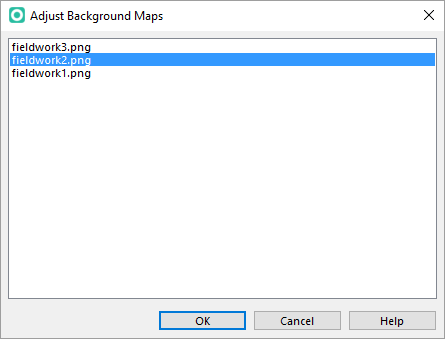
![]() Background maps from online WMS are not shown in this dialog box.
Background maps from online WMS are not shown in this dialog box.
A background map can be adjusted to the grid or to the map. A grid on the background map makes it easier to adjust it. The grid crossing points can be used for the adjustment (however, any points can be used).
It is possible to use 1 to 12 points for the adjustment. After choosing the Adjust command the cursor changes to a cross line with a black and white squared pattern. You are now in the Adjust mode. Do the following steps for each adjustment point:
- Mark a point on the background map (e.g. grid point or a surface reference point) by clicking it.
- Mark the same point on the map by clicking it.
In the bottom left part of the Status Bar you can always see, which point you have to mark at the moment, when you are in the Adjust mode.
When having adjusted enough points, execute the adjustment by pressing the Enter key. The background map is rotated and stretched to get the best fit for the adjustment points.
If the adjustment is not good use the Undo function to cancel the new adjustment.
![]() - If the size of the raster map corresponds exactly with that of the map scale and has not been rotated, it is possible to adjust it with the map using a single point pair. OCAD will correctly reposition the raster map without changing the scale or angle.
- If the size of the raster map corresponds exactly with that of the map scale and has not been rotated, it is possible to adjust it with the map using a single point pair. OCAD will correctly reposition the raster map without changing the scale or angle.
- - If the raster map is contorted, rescaled or rotated, you will need to use between 3 and 12 point pairs to adjust the image with the map. OCAD repositions the raster map by transforming it (affine transformation) and adjusts the scale and angle accordingly. The point pairs should be distributed equally across the map.
- - If the adjustment point pairs lie outside of the drawing window, you can move the map section between the adjustment point pairs during the adjustment process.
Error Adjustment points too close: When using several points for adjusting a background map, the outermost points must be separated by at least 2 mm on the background map.
Note: OCAD Background Maps cannot be adjusted. The Georeferencing is used to place the map or, if the map is not georeferenced, the origin of the background map (middle of the map, point (0/0)) is displayed on the origin of the current map.
Once you have completed the map adjustment, the raster map can be saved as a georeferenced raster map. The advantage of this is that the raster map will be loaded in the correct position the next time it is opened.
Export Georeferenced Raster Map
To save the raster map as a georeferenced raster map:
- Select the Export command in the File menu.
- Select a desired raster format (TIF, JPG, GIF or BMP)
- Select a Resolution (300 dpi is recommended for printing maps)
- Select the Create World file option
- Click the OK button.
Hide all Background Maps 





Choose the Hide All command in the Background Map menu or press the F10 key (Shortcut by default) to hide all background maps temporarily or make them visible when they are hidden. This command is active if one or more background maps are loaded.
If you want to hide only single background maps, choose the Manage command from the Background Map menu.
Manage Background Maps 





Choose the Manage command from the Background Map menu to set options for displaying and printing the background maps. The Manage Background Map dialog box is displayed. This is a non-modal dialog box. It is possible to switch between the dialog box and the map window without closing the dialog. Changes are directly updated on the map.
In the Manage Background Map dialog a table is displayed. In this table all loaded background maps are listed. The table consists of the following columns:
Visibility options





- V (Visible): You can make a background map visible or hide it by clicking the corresponding cell in this column. An eye icon in this column means that the background map is visible.
 To hide all background maps temporary use the Hide All command in the Background Map menu.
To hide all background maps temporary use the Hide All command in the Background Map menu.
- F (Visible in Background Favorites view mode): You can make a background map visible or hide it in the Background Favorites by clicking the corresponding cell in this column. An eye icon in this column means that the background map is visible in the Background Favorites.
- Dim: In this column you can enter a value in percentage to make the background map appear brighter, i.e. to dim it. 0% means the background map is displayed in its original colors. 100% means the background map appears completely white. Dimming is used to get a better distinction between the background map and the map.
- T (Transparent): If more than one background map is opened you can set them transparent so that both are visible. Activate this option by clicking the corresponding cell in this column.
Assign to Spot Color 



This feature is used in a special production process, namely to update old hand drawn or scribed maps. The printing plates for each spot color are scanned (black and white or gray-scale) and then used as background maps. When such a background map is assigned to a spot color, it is displayed with this color. In addition, when the Spot Color View is activated the background map is displayed together with the corresponding spot color.
Visit the Define Spot Colors page to learn more about spot colors.
Note: This feature is intended for black and white or gray-scale background maps. If a color background map is assigned, the resulting colors are undefined.
Blockout 



This column is labeled with a B and is only available for raster background maps. Click a cell in the Blockout column to use the corresponding background map as a block out mask.
If you have several black and white or gray-scale background maps which are transparent and assigned to a spot color, you can use this function to hide some background maps in a certain area of a different background map.
In the following example, there are four black and white or grey-scale background maps loaded. Each background map was assigned to a spot color. There are the purple, the black and the blue lines. The fourth background map was assigned to the yellow color. The Manage Background Map dialog looks as follows:
The yellow background map is used as a Blockout mask. The result looks as follows.
The black and the purple background maps are hidden behind the yellow areas when using Blockout. The blue background map is drawn over the yellow areas because it is over the blockout mask in the order of the background maps.
File name 





The file name of the background map is displayed in the File name column.
I (Information) 





Click on the ![]() information icon to get more information about the corresponding raster background map. The Background Map Info dialog box appears with additional information. The given information varies depending on the file type.
information icon to get more information about the corresponding raster background map. The Background Map Info dialog box appears with additional information. The given information varies depending on the file type.
Info for raster background map:
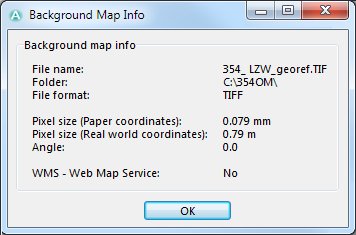
If an encrypted background map is load then a ![]() lock icon is displayed in the information column.
lock icon is displayed in the information column.
Click on the ![]() lock icon to get more information about the encrypted background map.
lock icon to get more information about the encrypted background map.
WMS
Background maps from online WMS are displayed with light blue color.
Other Functions 




- Move Up: Click the Move Up icon to move the selected background map one line upwards. Background maps which are listed in a upper position in the Manage Background Map table are diplayed in the foreground.
- Move Down: Click the Move Down icon to move the selected background map one line downwards. Background maps which are listed in a lower position in the Manage Background Map table are diplayed in the background.
 The selected background map can also be moved up and down with drag and drop on the file name column.
The selected background map can also be moved up and down with drag and drop on the file name column.
- Open: Click this button to open a new background map (Open a new Background Map).
 OCAD loads the background map hidden when pressing the Shift key while clicking the Open butten or menu item.
OCAD loads the background map hidden when pressing the Shift key while clicking the Open butten or menu item.
- Relink: Relink background maps to another directory.
- Remove all: Click this button to remove all background maps. This command does not delete the background map files.
- Remove: Click this button to remove the selected background map. This command does not delete the background map file.
- Close: Click the close button to quit the dialog.
Web Map Service - WMS 

Visit the Web Map Service page to get some information about this function.
Online Map Services
Visit the Online Map Services page to get some information about this function.
Back to Main Page
Previous Chapter: Create a New Symbol
Next Chapter: Import Files
